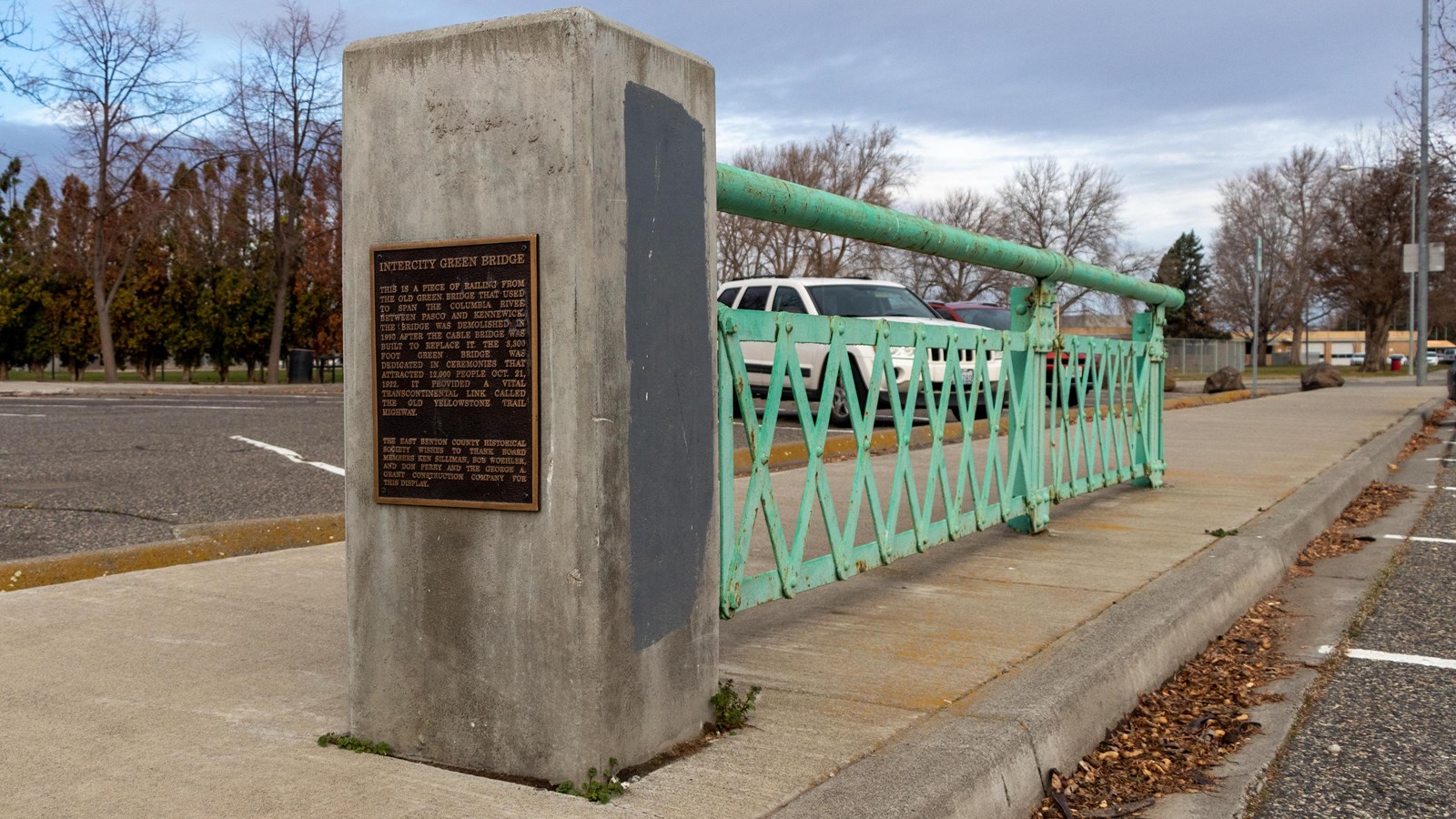Last updated: July 18, 2024
Place
Green Bridge Historical Marker

NPS/MURPHY
Built in 1922, the Pasco-Kennewick Bridge in southeastern Washington began as a symbol of unity and progress. As car ownership rose, Eastern and Western Washington wanted to expand the road system and economic opportunities. The two sides of the state collaborated on building a bridge across the Columbia River to replace a ferry between the rural towns of Pasco and Kennewick. The bridge became part of the transcontinental highway system and earned the nickname “Green Bridge” due to its green-colored paint.
No one could have known then that the Green Bridge would eventually gain a new and menacing significance, one of exclusion. The Green Bridge would become a dividing line between Kennewick, a community that sought to exclude Blacks, and Pasco, a community that sought to confine Blacks.
The change came with World War II as an influx of Black and White workers flooded the Hanford Construction Camp as part of the top-secret Manhattan Project. The camp was located upstream of Pasco and Kennewick on the Hanford Site. The workers knew they were building facilities related to national defense. They didn’t know that those facilities would produce plutonium for the atomic bomb dropped on Nagasaki, Japan in 1945.
Most general laborers came from out of state since the army chose to build the Hanford Site in a rural part of the Inland Northwest. The army’s main contractor, the DuPont Corporation, mainly recruited workers from the South where wages were low. DuPont promised Black and White women and men from the South higher wages if they would migrate to Hanford.
Hanford and the surrounding communities boomed overnight. About 15,000 Blacks arrived in what is now known as the Tri-Cities in 1943-45. At its peak, Hanford employed more than 50,000 workers. Although the pay was better, Blacks encountered a system of racial segregation much like the Jim Crow laws of the South.
The lack of housing was an acute issue for Blacks. Hanford Construction Camp offered some onsite segregated housing, but not enough to accommodate all the Black workers. Kennewick refused to allow Blacks to live within its community or stay in its hotels. Because Blacks were only hired as temporary workers, they could not live in the planned government community of Richland that was only for permanent workers like scientists.
The DuPont Corporation negotiated with Pasco to put one barrack and one bunkhouse in East Pasco for Blacks. Traditionally, the eastern side of the railroad tracks in Pasco had been a community for non-White railroad workers since Pasco birth as a railroad town in the late 1800s. This non-White community, which included several Black families, remained relatively small until Dupont and the rest of the Tri-Cities considered East Pasco the de facto place where Blacks should live outside of the segregated Hanford Construction Camp housing.
The one barrack and one bunkhouse didn’t fully ease housing needs. Some Blacks were forced into makeshift residences like trailers, shacks, and tents in East Pasco. Unlike West Pasco, East Pasco lacked basic city services like sewage connections, trash collection, paved roads, fire hydrants and streetlights into the 1960s.
While Pasco was trying to confine Blacks, Kennewick was trying to exclude them. Kennewick police would routinely stop Blacks passing through. Kennewick posted a sign on the Green Bridge that declared Kennewick as a sundown town, a place where Blacks aren’t allowed after sunset.
The exclusion continued after World War II ended and many Blacks left the Tri-Cities. The Hanford Site expanded in response to the Cold War and a second wave of Black migrants moved to the Tri-Cities. Katie Barton and her husband moved to Pasco in 1949 to work at Hanford. Katie Barton said, “They didn’t even want no Black people in Kennewick. You couldn’t buy a house there; you couldn’t go to the movies there; they wouldn’t put you in jail there. [The] Tri-Cities was worse than the south ever was because you knew where you stood there. But you didn’t know here you stood here.”
Today, a bridge still connects Kennewick and Pasco although it is no longer the Green Bridge. After engineers built a new cable bridge between the two cities in 1978, the citizens of Kennewick and Pasco voted to demolish the Green Bridge. Although almost all traces of the Green Bridge are gone, visitors can still see a piece of railing from the Green Bridge that is displayed in front of the Museum at Keewaydin.
Continue Your Journey
Visit the original location of the Green Bridge to learn more about the construction of the bridge. Do you want to see other sites that tell the African American story of East Pasco? Visit the Lewis Street Underpass to view the unofficial dividing line that segregated Pasco during the Manhattan Project. Go to Morning Star Baptist Church, the literal and figurative center of the African American community in East Pasco, to visit the city’s first Black congregation. Its roots date back to the Manhattan Project. Stop by Kurtzman Park and learn about the grassroots efforts that created the first community park in East Pasco. Take a tour of B Reactor and stand in the shadow of this world-changing building that teams of African American laborers helped construct.
